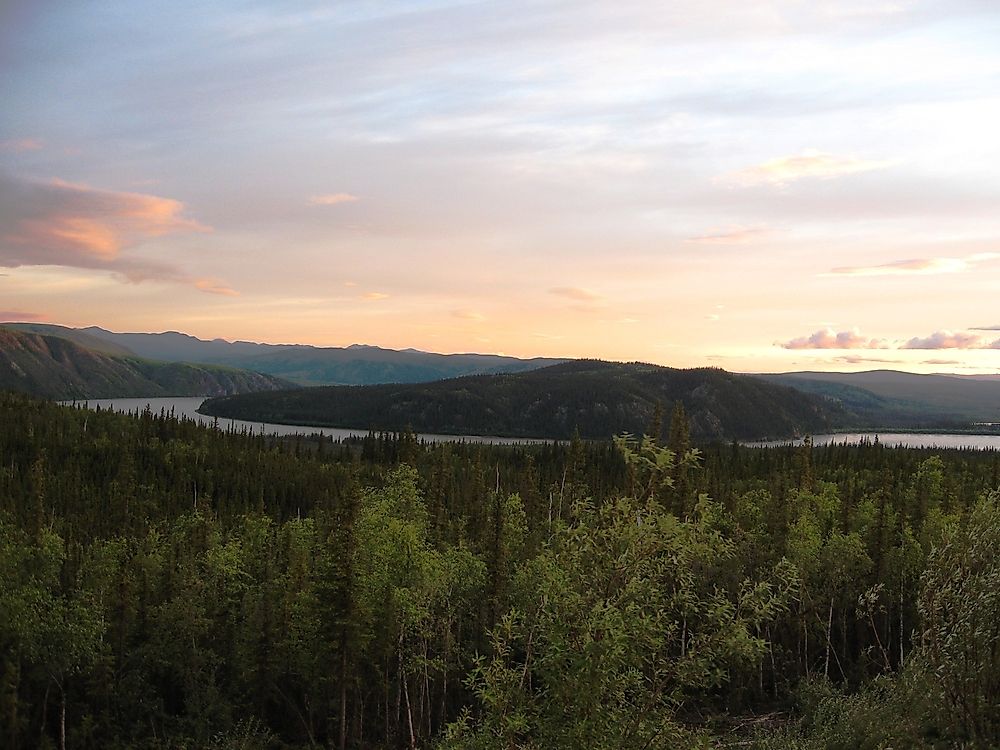The 10 Longest Rivers in Alaska

Approximately 40% of U.S. surface water resources are located in the state of Alaska. These surface water resources include 12,000 rivers, more than 3 million lakes, and thousands of creeks, ponds, and streams. Rivers in Alaska are important components of the boreal forest ecosystem, are important travel corridors, and form unique riparian habitats for terrestrial animals. The major interior river systems of Alaska include the Yukon River, Koyukuk River, and Kuskokwim River. These major rivers are fed by thousands of tributaries that create networks of water connections throughout the boreal forest. Alaska has more than 365,000 miles of river, and ten of these rivers are at least 350 miles long. Some of the longest rivers in Alaska are highlighted below.
The Longest Rivers in Alaska
Yukon River
The Yukon River is a major river in North America. Its source is the Llewellyn Glacierin in British Columbia, Canada, and it flows for approximately 1980 miles until in empties in the Bering Sea. The river's course runs through Canada's Yukon Territory, and the lower half of the Yukon River lies in Alaska. It is the longest river in both Yukon and Alaska, and was a popular means of transportation during the Klondike Gold Rush. The river is currently home to one of the longest salmon runs in the world.
Kuskokwim River
The Kuskokwim River is located in Southwest Alaska. The 702-mile river is the 9th largest river in the U.S. in terms of discharge volume at its mouth. The Kuskokwim River is formed by the confluence of two rivers, the East Fork Kuskokwim River and the North Fork Kuskokwim River, and then flows to Kuskokwim Bay and the Bering Sea. In Alaska, the river emerges from Kuskokwim Mountain. The major economic activity along the river has historically been fur trapping and fishing.
Porcupine River
The Porcupine River is a 569-mile tributary of the Yukon River and is the third longest river in Alaska. The river originates from the Ogilvie Mountains in Yukon, Canada, and flows through the Old Crow community before veering southwest into Alaska, and finally into the larger river at Fort Yukon. The Porcupine River is an excellent place for boating. Boaters can travel by raft, canoe, and kayak. However, upriver winds may cause some difficulties to rafters.
Tanana River
The Tanana River is a tributary of the Yukon River. Its headwater is located at the confluence of the Nabesna River and Chisan Rivers in eastern Alaska, and then flows along the northern slopes of the Alaska Range and emerges into the Tanana Valley in Central Alaska. The river flows for 584 miles from its source before emptying into the Yukon River at the town of Tanana. Ice on the Tanana River accumulates during winter to an average thickness of 43 inches at Nenana. Each year thousands of people participate in a fundraiser known as the Nenana Ice Classic, which involves guessing the date and time when the Tanana River ice will melt.
National Wild Rivers in Alaska
25 rivers in Alaska have been designated "wild" and "scenic" rivers through the U.S. National Wild and Scenic Rivers Act. These rivers total more than 3,000 miles and range from lazy rivers to whitewater rapids. The longest wild and scenic River in Alaska is the Noatak River, which is located in the Arctic National Park and Preserve and measures approximately 420 miles from its headwaters in Mount Igikpak to its mouth in the Chukchi Sea.
The 10 Longest Rivers in Alaska
| Rank | River | Length (miles) | Length (km) |
|---|---|---|---|
| 1 | Yukon River | 1,980 | 3,190 |
| 2 | Kuskokwim River | 724 | 1,165 |
| 3 | Porcupine River | 569 | 916 |
| 4 | Tanana River | 569 | 916 |
| 5 | Innoko River | 500 | 800 |
| 6 | Koyukuk River | 500 | 800 |
| 7 | Noatak River | 420 | 680 |
| 8 | Porcupine River | 380 | 610 |
| 9 | Stikine River | 379 | 610 |
| 10 | Colville River | 350 | 560 |











